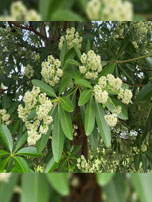SHAHEED KARTAR SINGH SARABHA AYURVEDIC MEDICAL COLLEGE & HOSPITAL
Affiliated to Guru Ravidas Ayurved University, Hoshiarpur Punjab
Affiliated to Guru Ravidas Ayurved University, Hoshiarpur Punjab

Botanical Name : Alstonia scholaris (Linn.) R.Br.
Family : Apocyanaceae
Introduction :
This plant used in skin disorder also used as anti malarial drug. Alstonia sp. is known as Fever Bark. A. scholaris is native to Australia and Southeast Asia. it as a good blood purifier.
Names in different Indian languages :
English : Devil’s tree, Dita Bark tree, shaitan wood
Hindi : Chattiyan, saittan ka jat
Kannada : Hale
Malayalam : Elilampala, pala, yakshippala, daivappala
Sanskrit : Saptaparnah, saptachadah
Tamil : Elilappalai, palai
Telugu : Phalangaruda, edakulaphala
Unani : Chhaatim, Kaasim
Folk : Chhitavan, Sataunaa
Synonyms :
Saptaparna, Saptaparni, Saptaahvaa, Vishaaltvak, Shaarada, Vishamchhada, Visãla, Visamacchada, sãrada, sãlmali patraka, Saptacchadä, Suparpaka
Classification according to Charaka, Susrutha & Vagbhata :
Charaka
Kubaghna, Udarda prasamana Kasäya skandha, Tikta skandha
Susrutha
Aragvadhãth, Laksädi
Vagbhata
Aragvadhãth
Varieties & adulterants – (CV – controversy, AD – adulterants) :
A. macrospea -[AD]
A. constricta -[AD]
alstonia venenata
Morphology :
A large tree with 6-8 m. height, whorled branches and bitter milky juice. Grayish bark, rough, lenticellate abounding
Leaves, in whorls of 5-7, some times 11, glabrous oblong or obovate oblong obtuse. Pale beneath, whorled phyllotaxy
Flowers- small, greenish or greenish-yellow fragrant, borne in umbel, corolla tube short.
Fruits- slender follicles, 30-50 cm long, in pendulous Clusters.
Seeds: Possessing brown (Flowers from December-march )
Distribution & Habitat :
Sub-Himalayan tract, West Bengal, Bihar, Peninsular India and Andamans [In the Himalayas, it grows at a height of 1000 m- this height limit not applicable other place. It is mainly found in Bengal, South India and West coast of India.
Chemical constituents :
indole alkaloids, reserpine, echitamine, Akuammidine (rhazine); picrinjne; strictamjne, tetraliydroalstonine , norangustilobine,losbanjue alschomine isolschomine alstonamine; echitamine, tubotaiwine, alstonamine scholaricine etc
Properties :
Rasa -Tikta, Kasãya
Guna- Laghu, Snigdha
Vipãka -Katu
Virya -Usna
Karma : Tridosahara, Dipana, Hridya, vrana hara, raktha prasadana
External uses : It is useful in skin diseases and in wounds. The paste of the bask is applied in putrefied wounds
Internal uses :
Digestive system : It stimulates the stomach, acts as an appetizer and also improves peristalsis. It is astringent and anthelmintic while the latex acts as a laxative and that is why ills used in ascites. Detection or the powder of bark is used for loss of appetite, abdominal pain, abdominal lump and dysentery. Bark and leaves increase appetite. Twigs of the free are used for brushing teeth as it bactericidal. Saptaparna is also useful in thread worms and round worm
Circulatory system : It acts as a blood purifier and cardio tonic. It is useful in splenomegaly, blood disorders and heart diseases.
Respiratory system : It is helpful in dyspnoea. The powder of flowers is used in headache for nasal administration.
Reproductive system : It improves appetite and is given to women after delivery. Saptaparna decreases fever, increases lactation and provides strength so women after delivery A mixture of bark of saptaparna + vacha + ginger + is given to women from the first day of delivery to protect her from lever.
Skin : It is useful in skin diseases. Juice of the leaves is helpful in skin diseases Mixture of decoction + chopchini is used in skin diseases.
Temperature : It is antipyretic and is especially useful in malarial fever. Its effect is the same as that of fever. but has no side effects like those of quinine. It is also helpful in reducing the temperature in fever. The paste of bask is applied over inflamed joints in chronic arthritis.
Indication :
Krimi, Kustha Vrana Amavãta svãsa, Gulma, süla.
Digestive, laxative, anthelmintic, febrifuge, antipyretics, depurative, fever, malarial fever, asthma, bronchitis, skin disease, diarrhoea, dysentery, dyspepsia, leprosy, debility, ulcers, psoriasis.
Part used :
Stem bark, Latex, flower
Dosage :
Decoction 50-100 ml
Powder 2-4 g.
Important Yogas or Formations :
Saptachhadadi kadha, Saptachhadadi taila, Saptaparna satvadi vati. Saptacchadãdi tailam, Saptacchadadi Kwãtha,
Therapeutic Uses :
(1) Krmi danta:Dental caries should be filled with latex of Saptapar and Arka Ksira (A.H.Ut22/20)
(2) Svasa: Juice of Saptaparn flowers is mixed with Pippali and taken with honey(C.S.Ci17/l.14)
(3) Sañdrameha: Saptapama decoction is useful (S.S.Cil 1/9).
